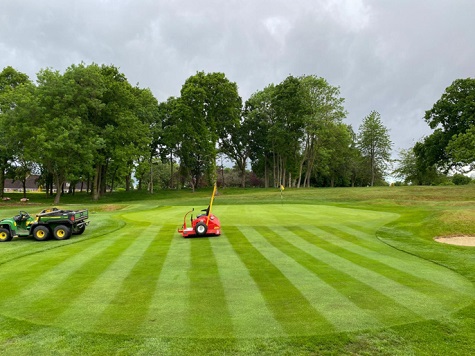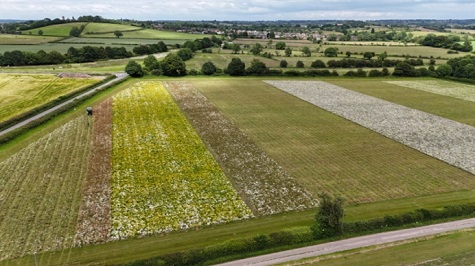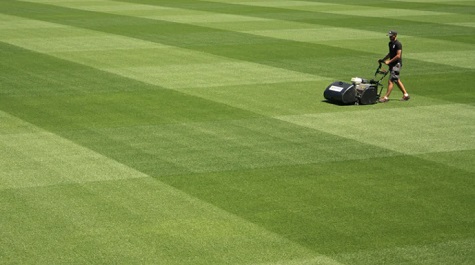

In this series of articles, I am taking the opportunity each month to look in more depth at individual organisations. How are they seeking to be more sustainable and, importantly, how are they seeking to advise and support members or customers?
This month we focus on DLF, major suppliers of grass seed and related products to the amenity sector.
In these articles, I have often referred to the need to take an integrated approach to the management of amenity and sports surfaces, particularly in terms of weed, pest and disease control. In that, choice of grass seed in establishing new, or restoring and maintaining existing, is a key component but one that can sometimes be overlooked. The correct choice can not only reduce incidence of future problems, but also very much contribute to delivering sustainable practice across all three pillars of economic viability, environmental impact and social considerations. This article looks at a global business with its key area of activity being the supply of grass seeds and operating alongside others in the UK in serving the amenity sector.
DLF is owned by Danish grass-seed farmers and its headquarters are in that country. However it provides locally adjusted products to more than 100 countries and has over 2000 employees. Alongside its supply network, it invests heavily in research and development and a key focus is on sustainability. This is set to further increase going forward. The grass seed business is divided into three main sections by DLF, namely forage & agriculture, sport & landscape and lawn & garden. It is the latter two of course which are within the amenity sector.
The professional turf market is constantly looking for improved varieties to meet the high demands of professional turf managers. Exceptional wear tolerance, a fine dense appearance, improved genetics, and tolerance to disease and drought are key benefits modern landscapers, groundsmen and greenkeepers are looking for. R & D at DLF seeks to provide varieties which can offer environmentally friendly mixtures and single varieties to safeguard turf against climate changes and the delivery of sustainable practice. Similarly in terms of lawns and gardens, finding the right grass for a lawn depends on the circumstances. Is the lawn in the shade of trees? Or perhaps it’s bathed in sunshine with no irrigation? In such circumstances choice of seed is crucial.
A responsibility for sustainability
Geraldine Bagger is a vice president at DLF with responsibility for Sustainability and Corporate Communication based in Denmark and I had an interesting discussion with her. She starts by stating that, aiming to be more sustainable as a company and in serving its customers is not new at DLF. However, clearly it has become more in demand and become the focus for discussions recently. A key element in driving their research and development is the use of data. They have put great emphasis on data collection so they can model more precisely customer requirements in different parts of the world so as to meet local needs and conditions. This is the driver of all their research and development and breeding trials. They are also shortly to announce new initiatives focused upon supporting their global customers and helping them directly to adopt sustainable practice.

Everything in DLF’s view starts with genetics and nature’s own code to make sustainable changes. The constant search is for varieties which are more disease resistant, more nutrient efficient, and of higher quality. The key is to reduce the level of inputs needed. A major objective within the company is to reduce carbon footprints but there is also a need to protect the environment and secure the genetic diversity of plants and fauna. They state on their website that ‘’ to preserve biodiversity our grasses and legumes are innovated to perform well in multi-species mixtures where each variety contributes with certain benefits and, at the same time, do not outgrow the other species’’. It is clear that seed companies such as DLF are embracing the sustainable agenda rapidly.
At the sharp end
It was very useful to follow up my discussion with Geraldine by meeting up with Ian Barnett as a regional technical sales manager. This allowed a look at how it is at the sharp end in interacting with customers. Ian is keen at the outset to state that in his view, sustainable practice is good practice. He also emphasises that in meeting practitioners across the sector, discussing sustainable practice has become very much the norm. The drivers lie within local targets, especially in local authority situations, but also in response to growing national requirements and user pressure to demonstrate sustainability. Taking an integrated approach is very important to management of grass and turf situations and the impact of the correct choice of seed and its management is a key component. As example, Ian mentions the substantial growth in demand for wildflower seed, but choosing the right mix and maintaining it properly is crucial. Too often wildflower areas are not properly managed and invasives take over.

Ian believes that what he can offer is based upon the major DLF investment in research and development leading to extensive trials. Interacting direct with customers allows him to feedback to the research team changing requirements and disease issues. The UK trial plots are a very important element of the interaction with customers and creating ever developing knowledge. Sustainability is a key theme – breeding more resilient cultivars, choosing varieties to meet local climate challenges and those requiring less inputs.
Our discussion also referred to sustainable practice in staff operations. There are about 120 employed directly in the UK by DLF. Fleet cars are now all electric and careful planning of journeys cuts down on travel and hence carbon footprint. Virtual meetings are now commonly used but Ian emphasises that, in interaction with existing and potential clients, often face to face is required not least to allow direct inspection of turf and landscaping situations. Ian clearly enjoys his work and his enthusiasm for it shines through, He believes it highly important for all in the amenity sector to work together and DLF are strong supporters of both the UK Amenity Forum and recognised assurance schemes.
Choosing seed requires an integrated approach

In considering choice of seed and its maintenance, another key factor emphasised is soil management and again in producing this article I have had several discussions with soil professionals and researchers. Those in the business of managing turf have much to consider and evaluate including water quality and quantity, shade issues, budgets, drainage, thatch, layering, pests and aeration scheduling, in addition to adopting sustainable practice. Although people have different interpretations of what a balanced soil is, perhaps it can best be described as one with a balance among its chemical, physical and biological properties. All are important and cannot be considered in isolation.
Maintaining and nourishing a healthy soil with a strong food chain has numerous advantages. Beneficial microbes form a barrier around healthy roots, which many pathogens cannot penetrate and some of the beneficial bacteria and fungi produce toxins to kill pathogens. Some microbes eat pathogens and the plant, and beneficial microbes send biochemical signals to each other when the plant is attacked to encourage the plant to activate its own defence mechanisms and produce plant hormones called phytoalexins to help fight disease. Thinking about the biology of surfaces we manage in respect to soil quality and choice of grass seed and its future management help us to manage them more sustainably. Managing that surface correctly requires optimum compromise between turf quality and sustainable soil quality.
Conclusion
Taking an integrated approach requires multi-faceted consideration of many issues. All will impact upon the correct choice of individual components not least the seed choice. Much existing good practice already delivers sustainability but, as this series of articles has sought to show throughout, there are other actions needed to further deliver on the objective. Adopting sustainable practice at whatever level is based upon a series of small steps and, as always, I urge anyone involved in managing amenity and sports surfaces to start with an audit of current practice and build from there. This article has principally focussed upon seed. There are many considerations required but it is clear that much development is on-going and support is available.
While sustainability is on everyone’s lips nowadays, it has been at the core of good practice in amenity for decades.
"Every choice you make is a seed you plant. If you wish to harvest for the future, you must plant wisely today." - Gavin Nascimento
Previous articles in this series
SUSTAINABILITY IN THE TRAINING SECTOR
SUSTAINABILITY IN LOCAL AUTHORITIES
AN EXAMPLE OF SUSTAINABILITY IN MACHINERY SUPPLY
SUSTAINABILITY IN THE GOLF SECTOR
SUSTAINABLE PRACTICE IN THE AMENITY SUPPLY SECTOR